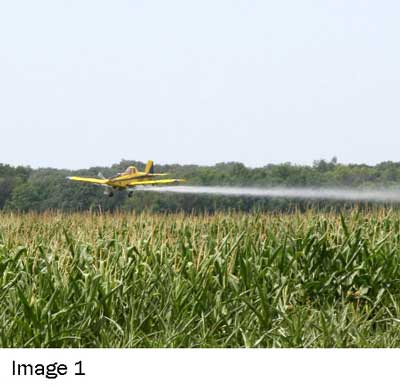
- Fungicide application to corn may be a good investment, even in years with low corn prices.
- The most important part of the decision-making process is to carefully evaluate risk on a field-by-field basis and apply the fungicides where needed most.
- Fungicide application timing is very important for both effectiveness of the application and avoiding unintended injury to the crop.
Introduction
Declining corn prices frequently cause us to neglect fungicide application, this year included. Ironically, current weather conditions, presence of multiple corn leaf pathogens, and late development of some fields stand to make this year one of the best years to apply fungicides. Here's why…
In an average year, with relatively little disease pressure, fungicide application to corn at, or shortly after, the VT growth stage commonly returns 12 to 15 bushels more grain than for untreated corn. This is primarily true of proven hybrids on productive soils. When leaf diseases threaten the corn crop, the yield return for fungicide application may be twice that amount. Even with reduced corn prices, fungicide application can be an economically sound decision for certain fields.
Increased corn yields from fungicide applications are the outcome of both disease suppression and highly visible improvement in apparent corn health, expressed as extended greenness and improved stalk intactness. Yet, fungicides will not significantly improve corn performance everywhere. The fungicide application decision should incorporate a number of considerations and evaluations of risk factors.
Corn Fungicide Application Considerations
Fungicide application timing is a critical part of the application decision. Presence or absence of foliar diseases should drive the fungicide decision but years of experience have shown that the best general timing for fungicides on corn begins when the last branch of the corn tassel is visible. Applications prior to this time risk development of arrested ear or "blunt ear syndrome," caused when highly active surfactants are applied with fungicides prior to the VT growth stage.
What about for fungicide application made after the VT growth stage? In past years, when foliar diseases threaten the crop, we have seen excellent results with fungicide applications all the way through the R2 (blister) growth stage. One should expect the level of return to decline, the later we go through the corn 'R' stages.
What about "defensive" hybrids? We have seen good returns for fungicide application to defensive hybrids when leaf diseases threaten the crop, but the level of return is usually slightly less than for highly productive, disease-susceptible hybrids.
What about the 'less productive' fields? Experience has shown that less productive fields still experience good economic return from fungicides if risk factors are present. In these fields, there should still be a good return for fungicide application, but not as high of a return, or as consistently, as for the more productive fields.
Corn yield improvement with fungicide application is tied to risk factors affecting the corn. The following list covers most of the major risk factors that can be offset by fungicide applications.
Risk Factors – (Support timely fungicide application.)
- Hybrid is Susceptible to Leaf Diseases
- Highly Productive Hybrid (often a Lancaster-type hybrid)
- Cropping Sequence or Rotation is Corn-After-Corn
- No-Tillage or Reduced Tillage (Leaves crop residue on the soil surface)
- Environment Favors Leaf Diseases (Fog, heavy dew, slow drying, low air movement)
- Field History of Corn Leaf Diseases
- Corn is Relatively Late Planted (Mid-May or later)
- Long-Range Weather Forecast from Mid-July, Through Late August, is for Clouds, Rain
- There is little tolerance for risk of yield reduction.
We suggest that two or more risk factors from this list may be enough to justify a fungicide application to corn.
Contact your FS Crop Specialist for your agronomic information.


Image 1: Fungicide application to corn at VT+ growth stage
Image 2: Gray leaf spot- a disease often alleviated with fungicide application
Image 3: Arrested ear (blunt ear) symptoms from surfactant application prior to VT growth stage